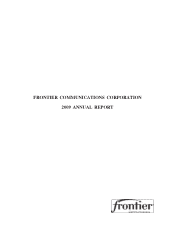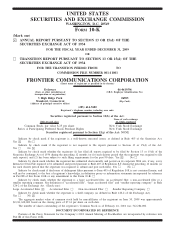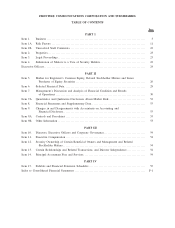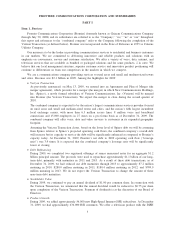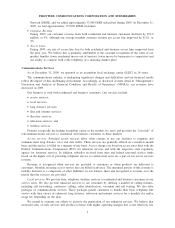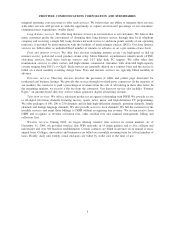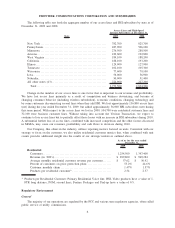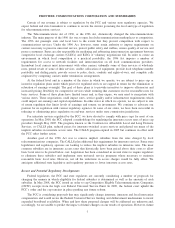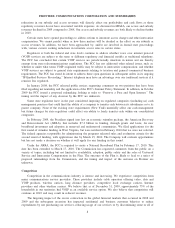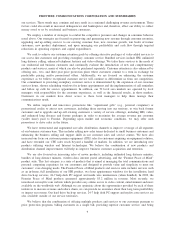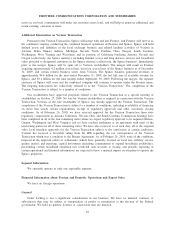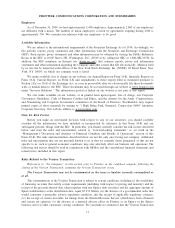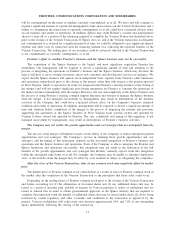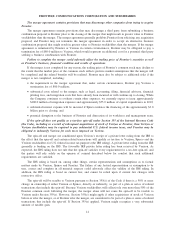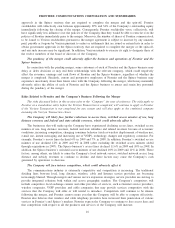Frontier Communications 2009 Annual Report Download - page 9
Download and view the complete annual report
Please find page 9 of the 2009 Frontier Communications annual report below. You can navigate through the pages in the report by either clicking on the pages listed below, or by using the keyword search tool below to find specific information within the annual report.Certain of our revenue is subject to regulation by the FCC and various state regulatory agencies. We
expect federal and state lawmakers to continue to review the statutes governing the level and type of regulation
for telecommunications services.
The Telecommunications Act of 1996, or the 1996 Act, dramatically changed the telecommunications
industry. The main purpose of the 1996 Act was to open local telecommunications marketplaces to competition.
The 1996 Act preempts state and local laws to the extent that they prevent competition with respect to
communications services. Under the 1996 Act, however, states retain authority to impose requirements on
carriers necessary to preserve universal service, protect public safety and welfare, ensure quality of service and
protect consumers. States are also responsible for mediating and arbitrating interconnection agreements between
competitive local exchange carriers (CLECs) and ILECs if voluntary negotiations fail. In order to create an
environment in which local competition is a practical possibility, the 1996 Act imposes a number of
requirements for access to network facilities and interconnection on all local communications providers.
Incumbent local carriers must interconnect with other carriers, unbundle some of their services at wholesale
rates, permit resale of some of their services, enable collocation of equipment, provide local telephone number
portability and dialing parity, provide access to poles, ducts, conduits and rights-of-way, and complete calls
originated by competing carriers under termination arrangements.
At the federal level and in a number of the states in which we operate, we are subject to price cap or
incentive regulation plans under which prices for regulated services are capped in return for the elimination or
relaxation of earnings oversight. The goal of these plans is to provide incentives to improve efficiencies and
increased pricing flexibility for competitive services while ensuring that customers receive reasonable rates for
basic services. Some of these plans have limited terms and, as they expire, we may need to renegotiate with
various states. These negotiations could impact rates, service quality and/or infrastructure requirements which
could impact our earnings and capital expenditures. In other states in which we operate, we are subject to rate
of return regulation that limits levels of earnings and returns on investments. We continue to advocate our
position for no regulation with various regulatory agencies. In some of our states, we have been successful in
reducing or eliminating price regulation on end-user services under state commission jurisdiction.
For interstate services regulated by the FCC, we have elected to comply with price caps for most of our
operations. In May 2000, the FCC adopted a methodology for regulating the interstate access rates of price cap
providers through May 2005. The program, known as the Coalition for Affordable Local and Long Distance
Services, or CALLS plan, reduced prices for interstate-switched access services and phased out many of the
implicit subsidies in interstate access rates. The CALLS program expired in 2005 but continues in effect until
the FCC takes further action.
Another goal of the 1996 Act was to remove implicit subsidies from the rates charged by local
telecommunications companies. The CALLS plan addressed this requirement for interstate services. Some state
legislatures and regulatory agencies are looking to reduce the implicit subsidies in intrastate rates. The most
common subsidies are in intrastate access rates that historically have been priced above their costs to allow
basic local rates to be priced below cost. Legislation has been considered in several states to require regulators
to eliminate these subsidies and implement state universal service programs where necessary to maintain
reasonable basic local rates. However, not all the reductions in access charges would be fully offset. We
anticipate additional state legislative and regulatory pressure to lower intrastate access rates.
Recent and Potential Regulatory Developments
Federal legislators, the FCC and state regulators are currently considering a number of proposals for
changing the manner in which eligibility for federal subsidies is determined as well as the amounts of such
subsidies. In May 2008, the FCC issued an order to cap Competitive Eligible Telecommunications Companies
(CETC) receipts from the high cost Federal Universal Service Fund. In 2009, the federal court upheld the
FCC’s order and the cap remains in place pending any future reform.
The FCC is considering proposals that may significantly change interstate, intrastate and local intercarrier
compensation and would revise the Federal Universal Service funding and disbursement mechanisms to incent
expanded broadband availability. When and how these proposed changes will be addressed are unknown and,
accordingly, we are unable to predict the impact of future changes on our results of operations. However, future
7
FRONTIER COMMUNICATIONS CORPORATION AND SUBSIDIARIES

